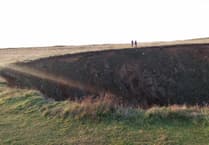Nature lovers are being asked to help protect Britain’s fastest declining mammal.
The People’s Trust for Endangered Species is calling for volunteer ‘water vole watchers’ to visit their nearest stream, river, ditch or canal and record what they find online to help protect the species.
Tell-tale signs include feeding stations, burrows in the riverbank, piles of droppings, or listening out for their characteristic ‘plop’ as they dive into the water.
There are 700 pre-selected sites that volunteers can survey across the country until June 15, or a new site can be registered.
No prior experience is needed, and free training via Zoom in April and May, and ID guides, are available online.
There are three sites in Cornwall and water voles were detected at two of them during the monitoring programme in 2023.
The results from the survey, which is part of People’s Trust for Endangered Species National Water Vole Monitoring Programme, helps conservationists find where water voles are living, how their populations are changing each year, and most importantly, where they’ are no longer found.
The data will help the People’s Trust for Endangered Species understand where water voles need the most help and implement targeted conservation efforts to help prevent further decline.
Such efforts include restoring degraded rivers, improving connectivity between wetlands, and controlling the spread of non-native American mink, the water vole’s main predator.
Emily Sabin, a water vole officer at People’s Trust for Endangered Species, said: “With their glossy dark brown fur, blunt snouts and furry tails, water voles are incredibly cute, but the decline they continue to experience is nothing short of alarming.
“Thankfully, in some areas water voles are starting to make a comeback due to habitat restoration work and increased mink control, but their numbers are still much lower than they should be.
“To prevent any further losses and to hopefully start seeing water voles across our waterways more broadly, we need as many people to take part in our survey as possible.”
176 sites were surveyed across the country last year, with water voles found at 53 of them.
This builds on 2022’s results where 95 sites were surveyed, with water voles spotted at 37.
Eleven sites in Essex had water voles present in 2023, the highest of any county, followed closely by Norfolk where water voles were spotted at nine sites.
The higher figures seen in eastern England is likely due to successful and ongoing water vole conservation work by the Waterlife Recovery Trust whose ground-breaking American mink eradication trial in East Anglia was declared a success in January 2024, with water voles finally thriving in the area.
A total of 1,174 sites have been surveyed since the National Water Vole Monitoring Programme was established in 2015.
These include 677 pre-selected sites by People’s Trust for Endangered Species and 497 newly registered sites, showing that even if there isn’t a pre-selected site near to where a volunteer lives, they can still take part.
Emily added: “Whiling away a few hours along a local waterway surveying for water voles is really enjoyable and rewarding, but it’s also a fantastic way to take part in conservation and to make a difference to the wildlife that lives around us.
“Over the past nine years hundreds of volunteers have taken part each year, but more help is desperately needed to fill the gaps.
“If you have any spare time between now and June then I’d urge to you get involved if you can.”
To become a water vole watcher, access the free online training or to find out more, visit www.ptes.org/watervoles





Comments
This article has no comments yet. Be the first to leave a comment.